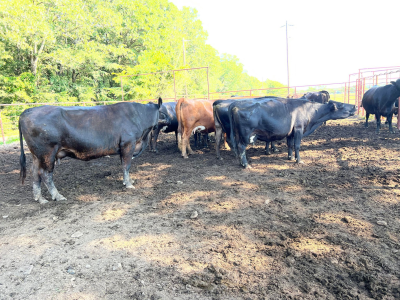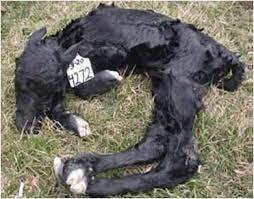puzzled in oregon
Well-known member
- Joined
- May 31, 2020
- Messages
- 830
- Reaction score
- 1,101
Uh Oh !!!! The dreaded "Spotted Syndrome Defect".Sometimes, boom, we get something like this.. From the old school sim blood View attachment 31057

Uh Oh !!!! The dreaded "Spotted Syndrome Defect".Sometimes, boom, we get something like this.. From the old school sim blood View attachment 31057
So, thats what we have done over the years. In the 90s, we had the sim, simbra, limo bulls. Our cows were tall. Then got into angus and with crossing them this way and that, we now have shorter big bodied cows. That was our first step and it took years. Now, i just love the dark brindle color. I find it exciting to see where we can take it. Today, we kept 3 calves bulls. 2 brindle and one black brangus cross from the neighbors bull. He's pretty spectacular. I cant remember what cow he's out of, but i'll go out there and be reminded.Guaranteed that spotted calf is NOT out of a PB Angus bull or PB Angus cow.
I'll defend the "big cow".
My herd average is probably 1550# - 1600#. Little cows are a waste of time up here. Extreme cold in winter and lush pastures in summer. Lots of research has proven cow weight vs feed intake is not linear. I like my 700# - 750# WW, but mainly I'm producing replacement breeding stock. Average probably 5.5 - 6 FS. Not a lot of leg, just big tanks. People used to grab a tape and measure for FS before buying. Not any more. No one is looking for the tall monsters of years ago. I always said, I could make them smaller framed in a heart beat - as soon as breeders were willing to pay for shorter. I LOVE my phenotype now.
What i've heard from the show crowd, spotted is back in. Apparently if you have any of that old blood, people are looking for the color in red/white, yep, red/white.Uh Oh !!!! The dreaded "Spotted Syndrome Defect".

I know a lot of people who dont breed their heifers till that second year. We use to wait and then started breeding them earlier. So, technically, we're getting a calf a year earlier and maybe 10% dont breed back. What happens then is they grow enormous if they arent nursing a calf. So we'll have a uniform herd, then a couple big ones....lol... This cow calved her first calf during snowmagedden. Like in the peak time. The calf was stupid and frozen and we just couldnt get it to nurse. So i took it in and bottle fed it till we had a cow lose a calf, i then grafted the calf onto another cow. Meanwhile, heifer grew.. If they have a second calf, they stay a good size. If not, we get this. She's on the left, much bigger than the others. Great cow, grows a awesome calf. All our cows have the potential to be huge, but if they are working, they stay smaller.The cow he is out of missing her 2nd calf would be a black dot against her and him here, actually 3 black crosses. She would have to have a pretty good excuse for it to stay.
Ken

Its technically accidental. A product of our mixes. I tend to keep all the really nice brindles. But, we do have all the other colors. If i can concentrate them into their own herd, i will one day.Don't chase color.
When I had registered Angus it was in the time of the NH, AM, CA, DD situations. You test for it, or years ago they close bred a sire to so many of his daughters to find out if they are clean or not. Quite frankly, it may aggravate sone Angus folks but many of us believe that several of those traits were brought in from other breeds years back during the years of the frame race and following.And these are only the ones listed. New abnormalities crop up and disappear because they are caught early and any surviving calves are terminal, and the herd they come from are terminated too.
- These are brick walls
- achondroplasia (bulldog dwarfism)
- alopecia
- ankylosis
- arthrogryposis (palate-pastern syndrome, rigid joints)
- arthrogryposis multiplex (AM, curly calf syndrome)
- brachynathia inferior (parrot mouth)
- cryptorchidism
- dermoid (feather eyes)
- double muscling
- fawn calf syndrome
- hypotrichosis (hairlessness)
- hypotrichosis ("rat-tail")
- idiopathic epilepsy (IE)
- mannosidosis
- neuraxial edema (maple syrup urine disease)
- neuropathic hydrocephalus (NH, "water-head")
- oculocutaneous hypopigmentation (white eyes)
- osteopetrosis (marble bone disease)
- polydactyly (extra toes)
- progressive bovine myeloencephaly (weaver calf)
- prolonged gestation
- protoporphyria (photosensitivity)
- pulmonary hypoplasia with anasarca (PHA)
- syndactyly (mule foot)
- tibial hemimelia (TH)
- translocations
I know a (human) couple that married and had three kids even though they are first cousins. They appear healthy. Their kids are all deaf.
And as for me "understanding", (@Allenw @elkwc), I'll stick to the fact that most people practicing inbreeding/line breeding don't know as much as they think they do. You can gang up on me all you want and it doesn't make either of us right or wrong. The list speaks for itself.
And these are only the ones listed. New abnormalities crop up and disappear because they are caught early and any surviving calves are terminal, and the herd they come from are terminated too.
- These are brick walls
- achondroplasia (bulldog dwarfism)
- alopecia
- ankylosis
- arthrogryposis (palate-pastern syndrome, rigid joints)
- arthrogryposis multiplex (AM, curly calf syndrome)
- brachynathia inferior (parrot mouth)
- cryptorchidism
- dermoid (feather eyes)
- double muscling
- fawn calf syndrome
- hypotrichosis (hairlessness)
- hypotrichosis ("rat-tail")
- idiopathic epilepsy (IE)
- mannosidosis
- neuraxial edema (maple syrup urine disease)
- neuropathic hydrocephalus (NH, "water-head")
- oculocutaneous hypopigmentation (white eyes)
- osteopetrosis (marble bone disease)
- polydactyly (extra toes)
- progressive bovine myeloencephaly (weaver calf)
- prolonged gestation
- protoporphyria (photosensitivity)
- pulmonary hypoplasia with anasarca (PHA)
- syndactyly (mule foot)
- tibial hemimelia (TH)
- translocations
I know a (human) couple that married and had three kids even though they are first cousins. They appear healthy. Their kids are all deaf.
And as for me "understanding", (@Allenw @elkwc), I'll stick to the fact that most people practicing inbreeding/line breeding don't know as much as they think they do. You can gang up on me all you want and it doesn't make either of us right or wrong. The list speaks for itself.
Inbreeding to bring them out and cull carriers.And how do you "deal" with genetic defects before they show up? How do you avoid them?
(facepalm)Inbreeding to bring them out and cull carriers.
I like what you have accomplished and what your goals are. You are not getting fixated with just one goal. I think a goodWhat i've heard from the show crowd, spotted is back in. Apparently if you have any of that old blood, people are looking for the color in red/white, yep, red/white.
I know what you mean if they have a year off, I have had a few over the years they get big when not being productive. I actually get a bit embaressed about people seeing ones like that in my herd now. I have upped the anti a bit with mine now they have to calve at 2 yrs of age and everything in the herd gets just one round of AI and the with then with the bull. I shoot for everything to calve in the month of July, any that fall outside this gets found a new home. I have decided there will be no exceptions and am excited to see the results down the track. I have got things pretty tight over the last couple of years but now I want to plug up any of the cracks and take it to a new level.I know a lot of people who dont breed their heifers till that second year. We use to wait and then started breeding them earlier. So, technically, we're getting a calf a year earlier and maybe 10% dont breed back. What happens then is they grow enormous if they arent nursing a calf. So we'll have a uniform herd, then a couple big ones....lol... This cow calved her first calf during snowmagedden. Like in the peak time. The calf was stupid and frozen and we just couldnt get it to nurse. So i took it in and bottle fed it till we had a cow lose a calf, i then grafted the calf onto another cow. Meanwhile, heifer grew.. If they have a second calf, they stay a good size. If not, we get this. She's on the left, much bigger than the others. Great cow, grows a awesome calf. All our cows have the potential to be huge, but if they are working, they stay smaller.View attachment 31081
1. I don't fear inbreeding... I fear the indiscriminate and ignorant use with people that have no understanding of the serious genetic issues involved. And I fear those that would promote it to people as though it has no consequences.I know what you mean if they have a year off, I have had a few over the years they get big when not being productive. I actually get a bit embaressed about people seeing ones like that in my herd now. I have upped the anti a bit with mine now they have to calve at 2 yrs of age and everything in the herd gets just one round of AI and the with then with the bull. I shoot for everything to calve in the month of July, any that fall outside this gets found a new home. I have decided there will be no exceptions and am excited to see the results down the track. I have got things pretty tight over the last couple of years but now I want to plug up any of the cracks and take it to a new level.
On in/line breeding I use my own bulls and due to some failed semen I had a lot of work for the bull to do, he was out of probably my best cow and he got to breed a couple of his half sisters and his mother. I am hoping to get some heifers from these close matings to retain especially to his mother. Unlike Travlr I don't fear inbreeding, I feel genetic conditions if they do occur can be easily handled with the technology available today especially with the database and resources available in the Angus breed and contrary to what Travlr tries to imply whole herds have not been lost to genetic conditions in the past they have been easily managed, registered cows can even be kept in the stud herd and progeny tested for their carrier status alternatively they just go to the commercial herd and a carrier free bull used on them for the rest of their commercial life.
As far as your situation with inbreeding I doubt in the unlikely event that a genetic defect did crop up little damage would be done and easily dealt with as your genetics are not going far and wide. With recessive conditions only an occaisional cow will carry the defect and if mated to a carrier bull even then only 1 in 4 calves will be homozygous for the defect and display it, certainly not whole herds wiped out. I have been through all this with Travlr before and know his views so I won't say any more on the subject.
Ken
